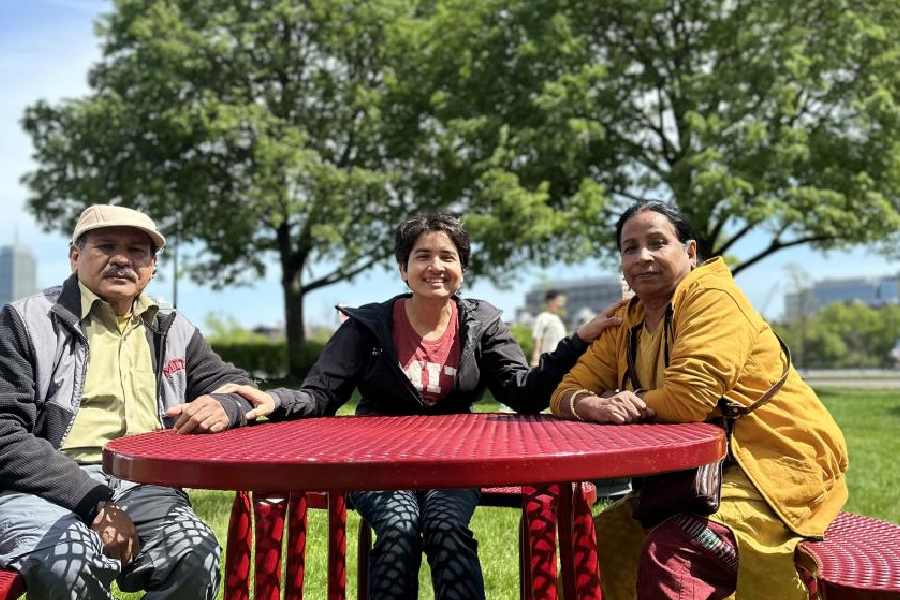Deblina Sarkar is not keen to tell her story. She is not disinterested either. Over a Zoom call from Boston, US, she comes across as matter of fact, pleasant and rooted in her work — she cannot wait to be done with this interview and return to the lab.
The story of her journey from rural Bengal to Boston is full of silences — studied, not awkward — and shorn of specifics as if she has already measured the distance she wants to maintain between her story and audience.
But when she does talk, she doesn’t do platitudes. When I ask her what it is she wanted to do as a girl, she replies, “I wanted to create knowledge, add to the production of knowledge rather than just implement what already exists.” She says it simply, self-assuredly and in a non-self-important tone. If I slip into Bangla, she too replies in her mother tongue, but switches to English whenever she is discussing her work and the specifics of it.
And, yes, the only time she shows emotion and smiles a wide smile that rises to her eyes is when she talks about her parents, Barid Baran and Asima, and nephews Qubit and Quitron.
Barid Baran and Asima are far more animated when it comes to telling the story of Deblina’s journeying. Which is why, Deblina’s story is best told with them in the role of chief narrators.
“When she was only three, she threw a tantrum because she wanted to go to school,” says Barid Baran. Indulging her would mean quite the long commute. It meant walking two kilometres to the Nangi train station and then getting off at Tollygunge and walking some more to reach the school itself.
It was not very different from Barid Baran’s own story from his student days. In 1960s Bengal, there was no school in his village. So he trekked two miles on foot to go to the nearest school. He wanted to be a scientist, so when the time came to go to college he shifted to the nearest town with one.
Deblina was happy — no, delighted — to go to school. “I am lucky, my parents never treated me and my brother differently,” she tells me. As Asima tells it, if there was anything that made Deblina unhappy as a child, it was the teacher’s red pen. “She couldn’t bear to have anything in her notebook stricken off with a red pen.” Asima narrates a fond tale about the time Deblina was learning her English alphabet. Something about her mother saying “P” should be written in a certain way, and the little girl insisting her way was also correct.
In 1972, Barid Baran took the entrance test for the IITs and could not clear it. But the scientist in him continued to be, dabbling in inventions of his own. Deblina recalls watching her father build a washing machine that ran without electricity, a pulley that could lift heavy objects to the roof of the house.
Do dreams come coded with the DNA or does one contract them from close contact? Who can say? When she was in Class IX, Deblina started preparing for the Joint Entrance Examination. “Even the day before her Class X history exam, she was sitting with her physics texts,” says Asima. “I had to tell her, how will you go to IIT if you don’t pass your boards,” adds Barid Baran.
In 2004, Deblina joined what is today known as IIT Dhanbad. When news got around, the neighbours said, “Now she will be able to pay for her own dowry.” Deblina laughs at the memory. Thereafter, Deblina left for the US — a PhD in nanoelectronics at the University of California, Santa Barbara.
One might think it was a big leap, a big deal, and yet neither Deblina nor her parents make it sound that way. Instead they talk about how she comes home every year and behaves as if she never left, wears her old clothes, enjoys her mother’s maan kochu bata and machher jhol. And how they join her every time she has a conference in a new country — “She sends us tickets,” says Asima.
All three of them are more eloquent when it comes to holding forth on the nuts and bolts of life. Deblina talks about nanoelectronics like she is chatting about the weather. “Nanoelectronic devices consume a large amount of energy etc. etc.” So she started exploring other low-powered computational systems. She says, “If you think about it, the human brain is the most energy-efficient computational system.”
I am not sure if I am following the science talk, when she provides the answer herself. It was this line of inquiry that brought her to a territory she had vowed to never enter. Biology.
There were risks in making a transition this steep, but her mind was made up. To the question of what it feels like to be a woman in STEM, she just shrugs. “If I was ever discriminated against, I would not know,” is her answer.
What she and her team are doing today is this — trying to come up with a non-invasive, wireless nanoelectronic device that can coexist within the brain. They aim to treat diseases such as Alzheimer’s, Parkinson’s and even brain cancer using this method. She says with a smile and a nod, “We are hoping to start the clinical trial within the next two years.”
And yes, she is thinking of starting a scholarship for girl-students who need it back home to encourage them to be able to study science in high school.










